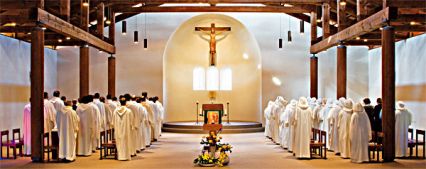Research project and scientific committee
VI International Liturgical Conference
HOLY ASSEMBLY
Form, Presences, Presidency
Bose, 5-7 June 2008
Monastery of Bose
National Office for the Church's Cultural Heritage of the Italian Bishops' Conference
 RESEARCH AND SCIENTIFIC COMMITTEE
RESEARCH AND SCIENTIFIC COMMITTEE
The choice of the Scientific Committee fell on the Altar as a point of departure (2003), then continued with the Ambo (2005), Orientation (2006), and the Baptistery (2007), all of them meant to show that the assembly of the faithful itself, as much as the liturgical space, are in relationship to the two fundamental poles of altar and ambo, and also the pole of the baptistery. The altar and the ambo “convoke” and “constitute” the Holy Assembly and as essential elements of liturgical space precede the assembly that is called together and remain even when the assembly disperses.
The choice of the holy assembly as the theme of the Sixth Conference corresponds to the internal logic of the reflection carried out over the past years. First of all, it will treat of the forms of assembly, which is a presence of bodies called to form a single body through words and silence, gestures and attitudes, postures and movements. The historical introduction will focus on the diverse typologies of the assembly, according to the diverse topographies of the liturgical meeting place. The reflections of an ecclesiologist will show how the different models of the assembly correspond to specific models of the Church. The holy assembly is both a mystery of presence and an epiphany of presences. “Presence” is both a philosophical and a theological category. This gives rise to the need for a philosophical reflection that delineates the plurality of concepts of “presence” within contemporary philosophy. Biblical data will show the plurality and the progressive evolution of manifestations of God’s presence. Within the assembly appear the different modes of reservation and of veneration of the Eucharist in East and West. Among the plurality of presences, liturgical presidency is an essential element of the Christian Eucharistic assembly. Together with the ordained minister, presidency implies a proper and distinct place within the assembly, the Episcopal cathedra or the presbyter’s chair. The place of the person presiding is not a third pole added to the two fundamental, altar and ambo. The chair, a sign of the ministry of him who occupies it, is at the service of the Word and of the sacrament of the altar and through them of the faithful gathered together. This leads to reflection on the ministry of liturgical presidency, with a look at the ethos of the conciliar liturgy. The theological and liturgical implications of the position of the presiding minister with respect to the assembly will be examined. The central part of the Conference will present and critically analyze some of the most significant contemporary examples of chairs and models for Eucharistic reservation in the main geographical regions of Europe.
Scientific Committee: Enzo Bianchi (Bose), Stefano Russo (Roma), Goffredo Boselli (Bose), Frédéric Debuyst (Louvain-la-Neuve), Paul De Clerck (Paris - Brussel), Albert Gerhards (Bonn), Angelo Lameri (Roma), Keith Pecklers (New York - Roma), Giancarlo Santi (Milano).